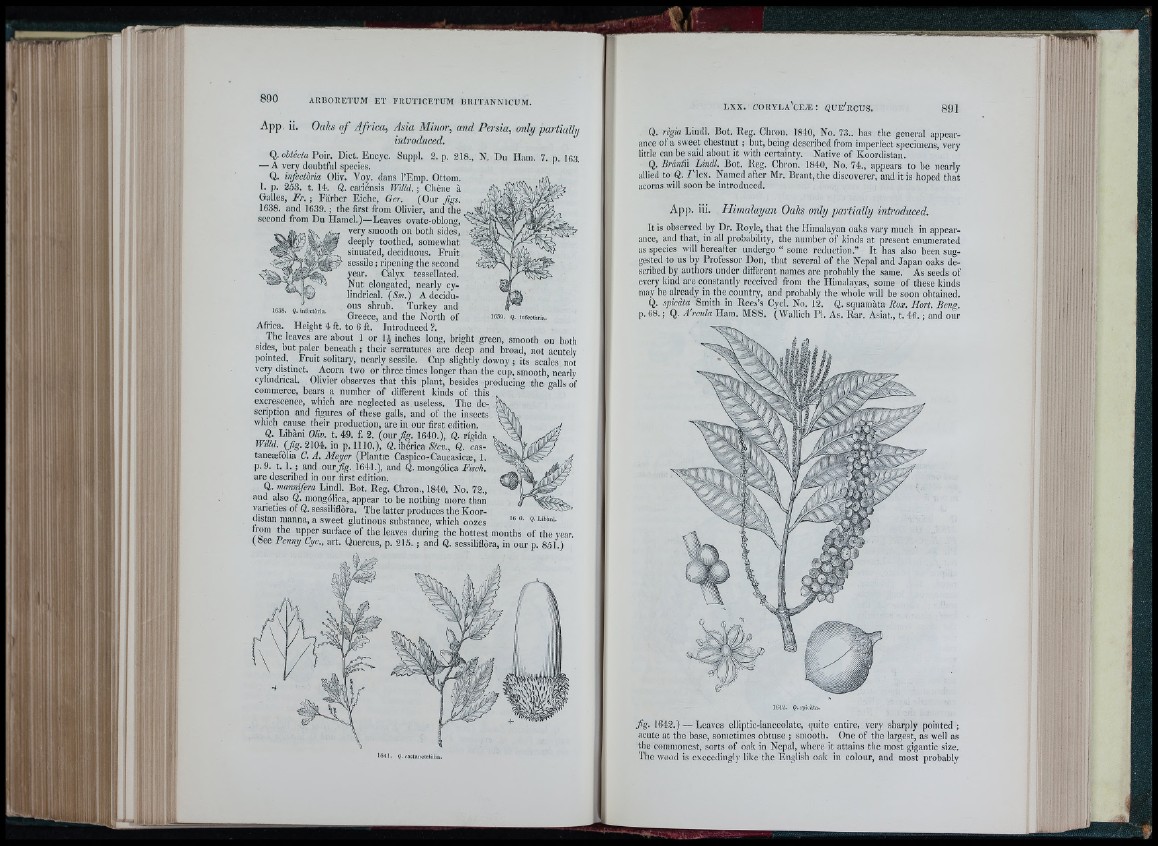
=iî '
i
S'-!
' â
■i . ä f :
ï r à í í í '
!■ : f i
:, t
: ' I;
I jl, :
) | j
Q. o5¿éfto P o ir. Diet. Encyc. S u p p l 2. p. 218., N, D u Ilam . 7 . p. ¡6;^
— A very doubtful species.
Q. infectòria Oliv. Voy. dans PEmp. Ottom.
I. p. 253. t. 14. Q. cariénsis Willd.; Chêne à
Galles, F r . ; F ä rb e r Eich e, Gcr. (O u r f g s .
1638. and 1639. ; th e first from Olivier, and th e
second from D u H a in e l.)—Leaves ovate-oblong,
1639. Q. infectòria.
very smooth on both sides,
deeply to o th ed , somewhat
ji sinuated, deciduous. F ru it
sessile ; ripening th e second
year. Calyx tessellated.
N u t elongated, nearly cylindrical.
(Sm .) A decidu-
tos. Q.i„fcc«,. OU3 Shrub Tu rk ey and
Ltreece, an d th e N o rth o f
Africa, Height 4 ft. to 6 ft. In tro d u c ed ?,
T h e leaves are ab o u t 1 o r IJ inches long, bright green, smooth on both
sides, b u t paler beneath ; th e ir se rra tu re s a re deep and broad, n o t acutely
pointed. ^ F rn it solitary, nearly sessile. Cup slightly downy ; its scales not
very distinct. Acorn two o r th re e times longer than th e cup, smooth, nearly
cylindrical. Olivier observes th a t this plant, besides producing th e galls of
commerce, beans a number o f different kinds o f this
excrescence, which a re neglected as useless. T h e description
and figures o f th e se galls, and o f th e insects
which cause th e ir production, are in o u r first edition.
« . Libàni Oliv. t. 49. f. 2. (o u r fig . 1640.), Q. rígida
Willd. ( / " . 2104. in p. 1110.), Q. ibérica Äea., Q. cas-
taneæfôlia C. A . M e y e r (P la n tæ Caspico-Caucasicæ, 1.
p .9 . t. 1. ; and ourjÆg. 164).), and 6 . mongólica Fisch.
are described in o u r first edition.
t ì . mannifera Lindi. Bo t. Reg. Chron., 1840, No. 72.,
an d also Q. mongólica, appear to be nothing more than
varieties of Q. sessiliflòra. T h e la tte r produces th e K o o r-
d istan manna, a sweet glutinous substance, which oozes
16 0. q. Libàni.
h-om th e u p p er surface o f th e leaves during th e h o tte s t months o f th e yea
(feee Fenny Cyc., art. Quercus, p. 215. ; and Q. sessiliflòra, in o u r p. 8 5 ).)
L X X . c o r y l a ' c e æ ; (JU e ' r c U S . 8 9 1
Q. règia Lindl. B o t. Reg. Chron. 1840, No. 73.. has th e general appearance
o f a sweet ch e stn u t ; bnt, being described from iiiiperlect specimens, very
little can be said ab o u t it with certainty. Native o f Ko o rd istan .
Q. lirm iS i Lindi. B o t. Reg. Chron. 1840, No. 74., appears to be nearly
allied to Q. / 'l e x . Named after Mr. Bran t, th e discoverer, and it is hoped th a t
acorns will soon be introduced.
A p |). ¡ii. H im a la y a n Oaks only p a r tia lly introdaced.
I t i s observed by Dr. Royle, th a t th e Himalayan oaks vary much in appearance,
and th a t, in all probability, th e number o f kinds a t p resen t enumerated
as species will herea fter undergo “ some red u ctio n .” I t has also been suggested
to us hy Professor Don, th a t several o f th e Nepal and Jap an oaks described
by au th o rs under different names are probably th e same. As seeds o f
every kind aro constantly received from th e Himalayas, some o f th e se kinds
may be already in th e country, and probably th e whole will be soon obtained.
Q. spicàta Smith in Ree s’s Cycl. No. 12. Q. squama ta Rox . Hort. Beng.
p. 68, ; Q. A'rcida Ham. M SS . (Wallich PI. As. R a r. Asiat., t. 46. ; and our
le-ia. Ç.spicàfa.
f g . 1642.) — Leaves elliptic-lanceolate, qu ite entire, very sharply pointed ;
acute a t th e base, sometimes obtuse ; smooth. One o f th e largest, as well as
the commonest, so rts o f oak in Nepal, where it attain s th e most gigantic size.
The wood is excecdiiigl\- like th e English oak in colour, and most probably
il- '